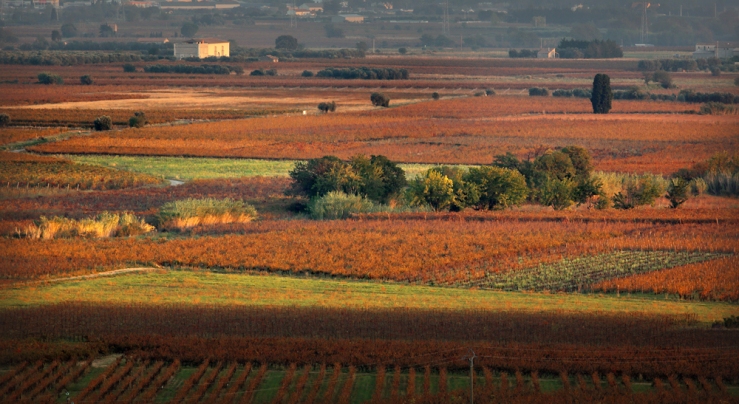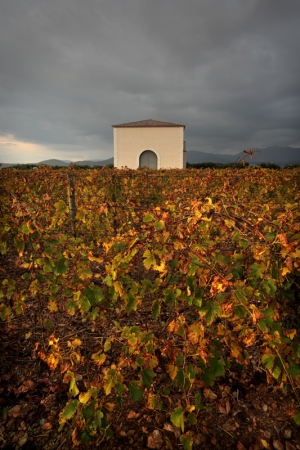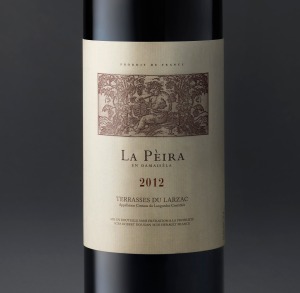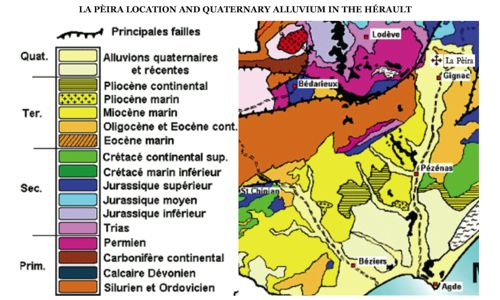Jancis Robinson on La Pèira vertical 2005-2013
“Below most significantly is an account of all vintages ever made of the grand vin of one of the Languedoc’s most ambitious estates, La Pèira en Damaisèla”
reports Jancis Robinson MW in her article on her November La Peira vertical tasting of the vintages 2005-2012.

November can be grim. “No sun – no moon! No morn – no noon – No dawn – no dusk – no proper time of day”, the poet Thomas Hood wrote of the month. But for its many imperfections, it’s surely the perfect month of the year to pair with red wine. You hear no no’s in November when the subject of a glass of red wine is raised. After November, merriness turns to indulgence, indulgence to indolence, indolence to reflection, and reflection to thoughts of self improvement, and with that the New Year has begun.
So it was that early in the New Year, Jancis Robinson MW published her November vertical tasting notes of the wine of La Pèira – vintages 2005-2013.
This was not the first vertical tasting of the La Pèira wines. No, the very first took place at royal warrant-holding wine merchants Berry Bros & Rudd London’s St James’ cellars on a June evening in 2011.
There, after an aperitif (Champagne Pierre Péters) several flights of older vintages of the wines of La Pèira were looked at by a small but appreciative audience lead by Simon Field MW.

The second occurred after strong spring rains in Southern France in 2013 with wine writer Andrew Jefford and was written-up for Decanter Magazine and Gourmet Traveller Wine. Gathered around a wooden table in the center of the chai at La Pèira, Mr Jefford marveled at the soil’s capacity to absorb the vast amounts of water these exceptional spring rains had visited upon them.
Anyway, fortunately for us – be it a valiant defiance of the November gloom, or a popular appreciation of the region – Jancis Robinson’s tasting article takes an in-depth look at the history, geology, and background of the La Pèira estate.
The article begins with an interested fact. Apparently, a recent survey of what articles are deemed most popular on her site reveal her readers have a particularly interested the wines of the Languedoc. As she relates, “I’m thrilled by this as I sincerely believe that the best wines of the Languedoc represent some of France’s best value: great handcrafted, terroir-influenced wine”.
On the La Pèira wines:
“These wines really are very good as they should be since they cost around £70 a bottle from their principal UK retailer Berry Bros although admittedly only about 300 cases are made each year. They also make about 500 cases of a second wine, the red Rhône blend Las Flors de la Pèira (about £30 a bottle), and a white blend Deusyls de la Pèira at the same price. And as though this were not enough, there is a varietal Mourvèdre called Matissat, about which I wrote last year in La Pèira’s varietal Mourvèdre.”
In a region where excellent wines are made from a blend of different grape varieties grown significant distances from each other on differing sites with various aspects and soils, La Pèira cuvée is unusual. Why? All the grapes are on grown on plots meters away from each other (on the Bois de Pauliau) and vinified meters away again. As Jancis reports:
“The grand vin is generally made up of about 70% Syrah and 30% Grenache grown, unusually for the region, side by side on the same soils, deep gravelly quaternary alluvium. Co-owner Rob Dougan describes these deposits as ‘set down here over the same period, and in the same way as those in the Médoc, Graves, St-Émilion or Pomerol but just on a different side of the Massif Central. Instead of the Gironde you have the Hérault river…”
The full article is here, and an excerpt follows:
Written by
La Pèira vertical and other Languedoc treasures

An analysis of which of our many articles is most popular reveals that you seem particularly interested in the Languedoc. I’m thrilled by this as I sincerely believe that the best wines of the Languedoc represent some of France’s best value: great hand-crafted, terroir-influenced wine, generally without the price tags associated with the most famous (I nearly wrote ‘best’) wines of Bordeaux, Burgundy and the Rhône.
Below most significantly is an account of all vintages ever made of the grand vin of one of the Languedoc’s most ambitious estates, La Pèira en Damaisèla. These wines really are very good – as they should be since they cost around £70 a bottle from their principal UK retailer Berry Bros – although admittedly only about 300 cases are made each year. They also make about 500 cases of a second wine, the red Rhône blend Las Flors de la Pèira (about £30 a bottle), and a white blend Deusyls de la Pèira at the same price. Then there is also what might be regarded as a third wine, Les Obriers de la Pèira, that retails at around £17 a bottle (see my tasting notes on a wide array of vintages with an average score of around 16 or 16.5). And as though this were not enough, there is a varietal Mourvèdre called Matissat, about which I wrote last year in La Pèira’s varietal Mourvèdre.
The 11.4-ha property is located on the wild terrain of the Terrasses du Larzac high above the Languedoc plain in the Hérault. The grand vin is generally made up of about 70% Syrah and 30% Grenache grown, unusually for the region, side by side on the same soils, deep gravelly quaternary alluvium. Co-owner Rob Dougan describes these deposits as ‘set down here over the same period, and in the same way as those in the Médoc, Graves, St-Émilion or Pomerol – but just on a different side of the Massif Central. Instead of the Gironde you have the Hérault river…
‘Oddly for this region, La Pèira’s Bois de Pauliau vineyard has been designated AOC for over half a century, as the most northerly of the two zones of the Clairette du Languedoc AOC (1948). Near La Pèira, and still in the Clairette AOC, France’s earliest known winery (10 AD) was discovered in 2007. Indeed, the first mention of French wine in literature as being of significant merit is found in Pliny’s Natural History (77-79 AD) in which the white wines of Baeterrae [Béziers] nearby are cited as worthy of note (alongside the resinous reds of Vienne). (Béziers is situated on a vast plain of quaternary alluvium that follows two seams northward along the Orb river toward St-Chinian and along the Hérault river toward the Terrasses du Larzac – see below). And, of course, Hugh Johnson states of this area in The Story of Wine: “These are the first extensive vineyards in France we can be certain about”.’
The property is co-owned by Karine Ahton and Robert Dougan with Jérémie Depierre as winemaker and Claude Gros as consultant. Varieties grown are Syrah, Grenache, Mourvèdre, Cinsault, Carignan, Viognier, Roussanne, Marsanne and Clairette. Here’s their assessment of the character of each of the vintages described below.
- 2005 – the first vintage; concentrated and ripe
- 2006 – a cooler year
- 2007 – a great year
- 2008 – another cooler vintage
- 2009 – a warm vintage
- 2010 – a great vintage
- 2011 – an excellent and very interesting year slightly more akin to the 2006, 2008
- 2012 – a lighter and unusual vintage for La Pèira which has produced very interesting results
La Pèira has had less than 10 years to establish a reputation whereas Mas de Daumas Gassac on the outskirts of Aniane south east of La Pèira has been waving the flag for top-quality wine from the Languedoc since its first vintage, 1978. Advised initially by the late Professor Émile Peynaud of Bordeaux, the Guibert family have put most of their eggs in the Cabernet Sauvignon basket. This can mean that in youth the reds can seem pretty callow, so I was delighted to have the chance to taste a fully mature example, a 2000, alongside the latest release of the red, and the particularly interesting and distinctive blended dry white. Richard is planning to attend a major vertical tasting of wines from this celebrated property just before Vinisud, the southern French wine fair in Montpellier, next month.
LA PÈIRA
La Pèira, La Pèira en Damaisèla 2012 Languedoc, Terrasses du Larzac
Mid ruby. Very different from the previous vintages – and I suspect not just because it is younger. Broader and more floral and transparent somehow. A real joker with none of the intensity of the previous vintages but with lots of sinewy appeal. Cool and fresh and with lots of freshness. To be drunk sooner than some? 14.5% Drink 2016-2022 17
La Pèira, La Pèira en Damaisèla 2011 Languedoc, Terrasses du Larzac
Crimson and not that dense. Mid crimson. Treacle notes with herbs and spices. Dry finish. Still neat and racy. Transparent. Lively. Overall there is the trademark combination of minerals and sweetness. Sweetness dominates at the moment. Then a bit chewy on the end. 14.5% Drink 2017-2030 17
La Pèira, La Pèira en Damaisèla 2010 Languedoc, Terrasses du Larzac
Very dark indeed. Complex, well-balanced nose. Still very youthful but with most impressive raw ingredients. Lots of both tannin and acidity. Young but hugely promising. Not too hot but very nuanced with a dry, terroir-driven finish. Neat, reminds me of a particularly good Douro red table wine. 14.5% Drink 2017-2030 18
La Pèira, La Pèira en Damaisèla 2009 Languedoc, Terrasses du Larzac
A warm year. Pruney colour. Scented and charming. More obviously sweet and pruney than the earlier vintages. Not as refreshing as some. A bit drying on the end. Very sweet overall. A dramatic wine but less my style than some others. Quite chunky tannins. Heat on the finish. 14.5% Drink 2017-2025 17
La Pèira, La Pèira en Damaisèla 2008 Languedoc, Terrasses du Larzac
A cool year. Dark brownish crimson. Scented and expressive. Quite marked acidity but lovely texture and fluidity. Still with tannins lightly in evidence on the finish. Dry, as opposed to sweet, overall. Lots of minerals and interest here – all nicely showcased. 14.5% Drink 2015-2023 17
La Pèira, La Pèira en Damaisèla 2007 Languedoc, Terrasses du Larzac
Dark purplish crimson. Particularly intense nose – so intense that it needs a great deal of coaxing out of the glass. Very intense, almost mentholated nose. Still introvert. Masses of tannin and fruit density but at the moment not much expression. Thick and embryonic with a bit of heat on the finish. 14.5% Drink 2015-2025 17+
La Pèira, La Pèira en Damaisèla 2006 Languedoc, Terrasses du Larzac
Healthy crimson. A cooler year maybe but a much more refined wine than the very slightly rustic 2005. Polished with a wonderfully sumptuous texture and delightful freshness on the finish after a richly dark-fruited start. There’s something black about this wine: tar? liquorice? But overall it has great presence on the palate. Neat finish. 14.5% Drink 2010-2022 17.5
La Pèira, La Pèira en Damaisèla 2005 Coteaux du Languedoc
Hot year. Very concentrated ruby right out to the rim. Warm and savoury on the nose. Really dense and satisfying, even if far from subtle. Quite a charge of tannins still – quite 2005 (as in Bordeaux)! Sweet and with a lightly burnt note. A wine to make an impact, and one that does slightly remind me of Trevallon. Sweet blackberry fruit on the finish and a certain graininess. As though the grape skins were pretty thick. 14.5% Drink 2010-2020 16.5
MAS DE DAUMAS GASSAC
Mas de Daumas Gassac 2012 IGP St-Guilhem-le-Désert
Viognier, Chardonnay, an unspecified Manseng and Chenin Blanc. Honeyed Viognier elbows its way to the front on the nose but there is admirable tang (thanks to the Manseng?) and acidity (Chenin?). Complex and saved from being fat. Already fun to drink but it tastes as though it will become more interesting. Still a bit tense on the finish. 13.5 Drink 2013-2017 16.5
Mas de Daumas Gassac 2011 IGP St-Guilhem-le-Désert
80% Cabernet Sauvignon. Still very youthful nose (to be fair, the back label suggests three to five years old for drinking young but up to 25 years for drinking it ‘en majesté‘. Dark crimson with more than a suggestion of warm earth underlying the Cabernet structure. Interesting wine with real depth but no excess of sweetness nor alcohol. Halfway between claret and La Pèira? It would be a waste to drink something so embryonic now but it certainly seems to have potential. Just a bit inky on the finish at the moment. 13.5% Drink 2016-2028 16.5+
Mas de Daumas Gassac 2000 Vin de Pays de l’Hérault
I had to guess at the alcohol since there was a mark over the relevant figure on the label. 80% Cabernet Sauvignon and the rest is a big mix. Pale evolved ruby. Tasted immediately after two rather smart 2000 St-Emilions, this by no means disgraced itself and arguably had more complexity and grunt. Lovely sweetness on the finish but really appetising savoury fruit beforehand. Good freshness too. Some floral notes on the nose and a little dusty soil taste on the palate. Good wine! 13% Drink 2009-2013 18
